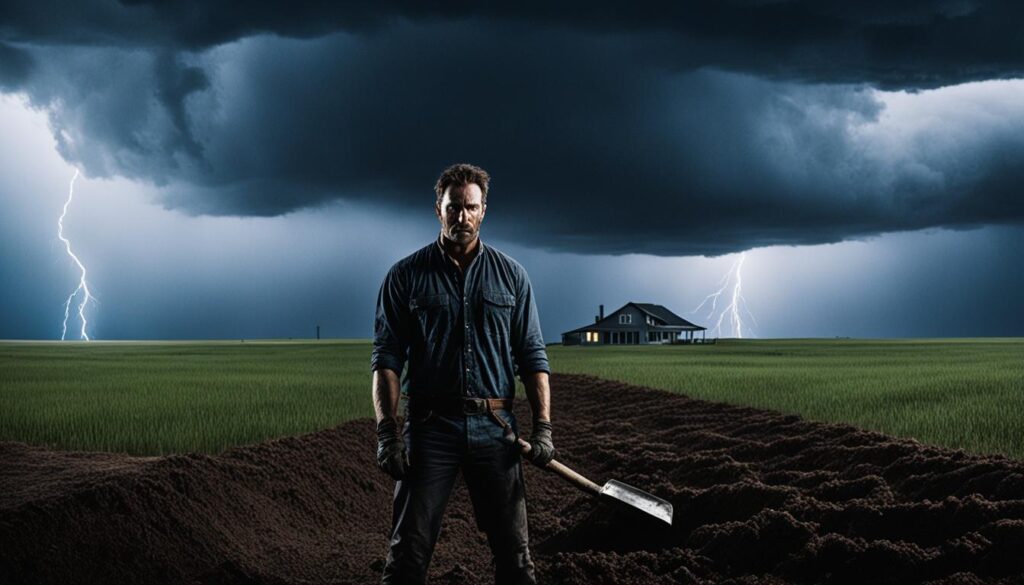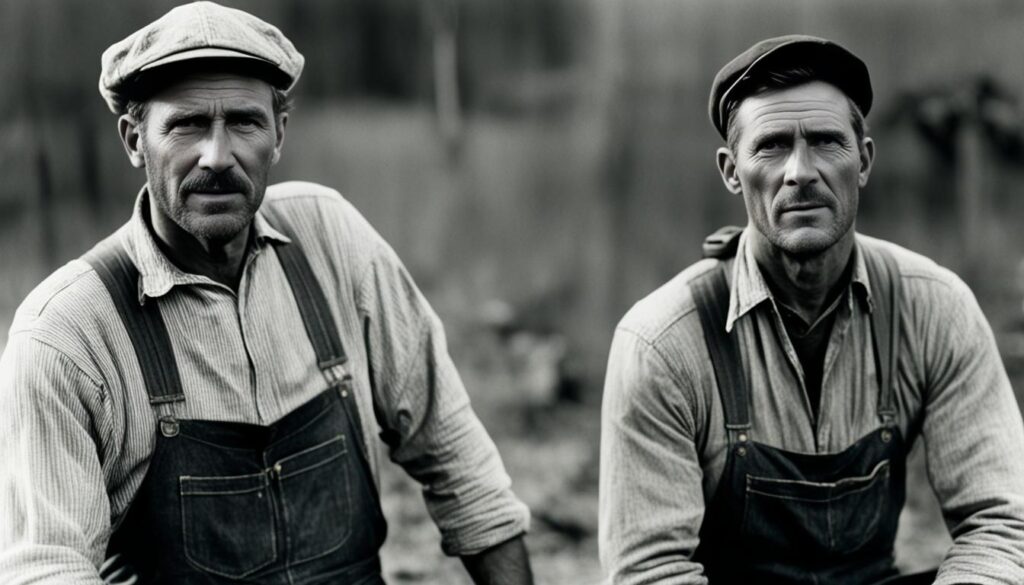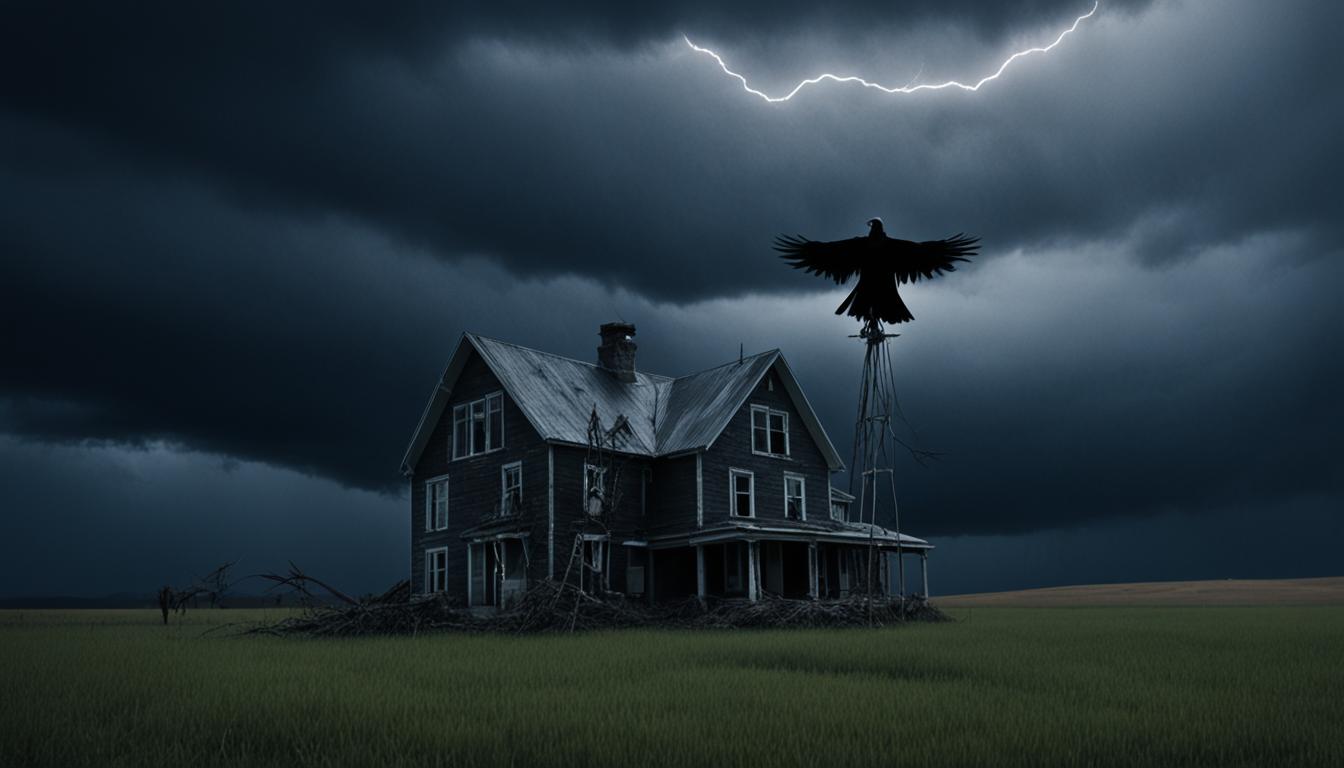Stephen King, the master of horror, delivered yet another chilling tale with his novella “1922.” This gothic-inspired story follows the journey of a farmer who murders his wife and faces the consequences of his actions.
From the macabre setting to the haunting characters, “1922” draws readers into a world of psychological terror and suspense.
In this article, we will explore the intricacies of this gothic tale and analyze the elements that make it one of Stephen King’s most gripping works.
Key Takeaways:
- Stephen King’s “1922” is a stunningly crafted gothic tale.
- The story centers around a farmer who murders his wife, delving into themes of guilt and psychological terror.
- The novella’s haunting characters and atmospheric setting create a chilling reading experience.
- King’s writing style and narrative techniques carry deeper meanings and messages throughout the story.
- “1922” has left a lasting impact on readers and writers alike, solidifying its place as a classic in the horror genre.
Introduction to “1922” by Stephen King
Stephen King’s “1922” is a disturbing and suspenseful novella that transports readers to a world of terror. The story is set in the year 1922 and centers around a farmer named Wilfred James, who lives in Nebraska with his wife Arlette and son Henry. When Arlette decides to sell their land and move to the city, Wilfred comes up with a plan to stop her. What follows is a haunting tale of murder, madness, and ghosts.
King’s exceptional storytelling skills are on full display in “1922,” and readers are sure to be drawn into the macabre world he creates. The novella is a masterclass in horror writing, with just the right blend of suspense, gore, and psychological terror.
The Background of “1922”
King originally wrote “1922” as a part of his Full Dark, No Stars collection, which was published in 2010. The novella was inspired by King’s fascination with the work of H.P. Lovecraft, as well as his own life experiences in rural Maine.
The Premise of “1922”
The story of “1922” is set in the fictional town of Hemingford Home, Nebraska, in the year 1922. It follows Wilfred James, a simple farmer who lives with his wife Arlette and son Henry on their farm. When Arlette wants to sell the land and move to the city, Wilfred devises a plan to stop her from leaving. The events that follow are dark, twisted, and terrifying.
Stay tuned to learn more about the plot summary, characters, and gothic elements of Stephen King’s “1922.”
Plot Summary of “1922”
Stephen King’s “1922” novella follows the story of Wilfred James, a farmer from Hemingford Home, Nebraska. Wilfred and his wife Arlette argue about their financial future as Arlette wants to sell their land and move to the city. Wilfred, however, wants to continue farming and raising their son, Henry, in the country.
With tensions mounting, Wilfred devises a plan to murder Arlette and persuades Henry to assist him. They carry out the plan in the middle of the night and dispose of her body in a well. However, after the murder, strange and terrifying events begin to occur, indicating that they have not truly gotten rid of Arlette’s presence.
As Wilfred’s mental state deteriorates, he discovers that he cannot escape his guilt and the horrors of his actions. In the end, he pays a heavy price for his misdeeds, as the supernatural forces at play exact their revenge.

Experience the psychological horror and suspense that King masterfully weaves in this unsettling tale of greed, guilt, and retribution.
Analysis of Gothic Elements in “1922”
Stephen King’s “1922” novella is a masterful work of gothic horror that explores the darker depths of human nature. The story is laden with Gothic elements that contribute to the chilling atmosphere which permeates throughout the narrative.
Gothic Elements
- The setting – The remote and isolated farmland of Nebraska intensifies the sense of claustrophobia and isolation.
- The supernatural – The appearance of rats, ghosts, and other supernatural elements heighten the sense of terror and dread.
- The supernatural – The wretched and decaying state of the human body symbolizes the deterioration of the soul.
- The sense of foreboding – The sense of foreboding and impending doom permeates throughout the narrative, creating a sense of unease and discomfort.
- Themes of sin and guilt – The story explores the the guilt one man feels after committing a heinous act and the punishments he receives as a result.
These gothic elements work together to create an eerie and unnerving atmosphere that grips the reader from start to finish.
If you appreciate gothic tales, then Stephen King’s “1922” is a must-read. It is a work that will linger with you long after the final page is turned.
Character Study in “1922”
Stephen King’s “1922” is a tale rich in complex and fascinating characters. From the guilt-ridden farmer Wilfred James to his resentful wife Arlette, each character is meticulously crafted to enrich the narrative and explore the psychological depths of human nature.
Wilfred James is the protagonist of the novella and a prime example of King’s ability to develop fully realized characters. Through his descent into madness, we see a man consumed by his own guilt and paranoia, leading him down a path of self-destruction. His wife, Arlette, is equally important, representing the strong-willed and independent woman that quickly turns to vulnerability in the face of her husband’s violence.
Their son, Henry, also plays a significant role, providing a valuable perspective of the events that unfold. As he struggles to come to terms with his family’s problems, we see the impact that trauma can have on a young mind. The additional cast of characters, including Sweetheart and the creepy Harlan Cotterie, add layers of complexity and intrigue to the story.
Through the characters, we gain insight into the human psyche and the motives that drive the narrative forward. As they confront their fears and inner demons, we’re left with a haunting portrayal of the human condition.

The psychological motivations of the characters
- Wilfred James is motivated by guilt and paranoia
- Arlette is motivated by a desire for independence followed by vulnerability
- Henry is motivated by a desire for stability and a need to understand his family’s problems
- Sweetheart is motivated by her own self-interest
- Harlan Cotterie is motivated by his own twisted desires
Overall, the characters in “1922” contribute significantly to the overall narrative and provide a haunting portrayal of the human psyche. Their complex motivations and psychological journeys make this novella a must-read for anyone interested in character-driven stories.
Setting and Atmosphere in “1922”
Stephen King’s “1922” is set in the heart of Nebraska, in a small, rural town that is plagued by droughts and economic hardships. The vast and desolate landscape adds to the overall sense of dread and unease that permeates throughout the novella. The barren fields and unrelenting heat create a stifling and oppressive atmosphere, which mirrors the psychological turmoil that the characters experience.
The vivid descriptions of the setting create a haunting backdrop that is both beautiful and terrifying. From the dark and foreboding corners of the cornfields to the dusty plains that stretch for miles, King paints a picture of a world that is harsh and unforgiving. The setting becomes a character in its own right, an inescapable force that pushes the characters to their limits.
The atmosphere of “1922” is tense and suspenseful, with a palpable sense of danger lingering in every scene. The characters are trapped in a world that is hostile and unforgiving, and the reader is drawn into their struggle for survival. The relentless heat and dryness of the setting add to the overall sense of unease, creating a feeling of claustrophobia that is both suffocating and exhilarating.
Writing Style and Themes in “1922”
Stephen King’s writing style in “1922” is a masterclass in creating a haunting and suspenseful atmosphere. His use of vivid and descriptive language immerses readers in the world of the novella, making it all the more terrifying.
One of the predominant themes in “1922” is the idea of guilt and its corrosive effects. King explores how guilt can consume a person, driving them to madness and ultimately punishment. The novella also delves into the consequences of greed and how it can lead to a person’s downfall.
The narrative techniques employed by King, such as the use of first-person narration and flashbacks, add to the overall sense of unease present throughout the novella. The underlying message of the story is particularly poignant – actions have consequences, and no secret stays buried forever.
Overall, “1922” is a gripping and chilling tale that showcases Stephen King’s writing skill and mastery of the horror genre.
Critical Reception of “1922”
Stephen King’s “1922” has garnered critical acclaim for its gripping storytelling, well-developed characters, and gothic atmosphere.
Critics have praised King’s ability to create a sense of dread and suspense throughout the novella, as well as his vivid descriptions of the haunting landscapes. According to The New Yorker, “King’s novella is an expertly crafted tale of guilt and retribution, with an atmospheric setting that lingers long after the last page is turned.”
Readers have also been captivated by the psychological horror present in “1922.” Many have praised the complex and flawed characters that make the story relatable and engaging. Reviewer Julio Ojeda-Zapata states, “King’s skillful writing and plotting combine to make 1922 a chilling page-turner that’s hard to put down.”
Overall, the critical reception of “1922” has been overwhelmingly positive, cementing its place as a standout work in King’s impressive career.
Legacy and Influence of “1922” by Stephen King
Stephen King’s “1922” is a milestone in the horror genre, not just for its captivating plot, but also for the legacy and influence it has generated.
The novella has left an indelible mark on King’s body of work as it contributed to the author’s exploration of psychological terror. “1922” delves into the descent of a protagonist into madness, and the story’s twisting narrative and immersive setting create an unforgettable reading experience.
Furthermore, “1922” has also impacted the genre of horror in several ways. It has been cited as an inspiration for writers who wish to craft suspenseful tales that explore the darker sides of humanity. The novella’s influence can be observed in the works of contemporary authors who experiment with gothic motifs and macabre themes.
The legacy of “1922” has also extended to popular culture. The novella has been adapted into a film by Netflix, featuring Thomas Jane as the protagonist Wilfred James. The film captures the eerie atmosphere of the story and is a testament to the enduring appeal of King’s writing.
In conclusion, Stephen King’s “1922” is a seminal work in the horror genre that has left a lasting imprint on readers and writers alike. Its legacy and influence continue to be felt today, and it stands as a testament to King’s mastery of the craft of writing.
FAQ
What is the book “1922” by Stephen King about?
“1922” is a novella written by Stephen King. It follows the story of a farmer in Nebraska who confesses to the murder of his wife and the chilling consequences that unfold.
What are the gothic elements present in “1922”?
“1922” incorporates various gothic elements like isolation, guilt, supernatural elements, and a gloomy atmosphere. These elements contribute to the haunting and suspenseful nature of the story.
Can you provide a plot summary of “1922”?
Certainly! In “1922,” Wilfred James, a proud farmer, recruits his teenage son to help him murder his wife, Arlette. They commit the crime in a remote location, but the guilt and supernatural occurrences begin to torment them and tear their lives apart.
Who are the main characters in “1922”?
The main characters in “1922” are Wilfred James, Arlette James, and their son, Henry James. These characters play crucial roles in the development of the plot and exploration of the story’s themes.
What is the setting of “1922” and how does it contribute to the story?
The story is primarily set in Hemingford Home, Nebraska, during the year 1922. The rural and isolated setting adds to the sense of dread and unease, enhancing the gothic atmosphere and the characters’ psychological journey.
What writing style and themes can be found in “1922”?
Stephen King’s writing style in “1922” is characterized by his keen attention to detail, vivid descriptions, and the exploration of inner darkness. The novella touches on themes such as guilt, the consequences of one’s actions, and the fragility of the human psyche.
How was “1922” received by critics and readers?
“1922” was generally well-received by both critics and readers. It was praised for its engaging storytelling, atmospheric writing, and the way it captures the essence of a gothic tale. However, some found the pacing to be slow in certain parts.
What is the legacy and influence of “1922” by Stephen King?
“1922” has left a lasting impact on Stephen King’s body of work and the horror genre as a whole. It is considered as one of his standout novellas, showcasing his ability to create suspense and delve into the darker aspects of human nature.



